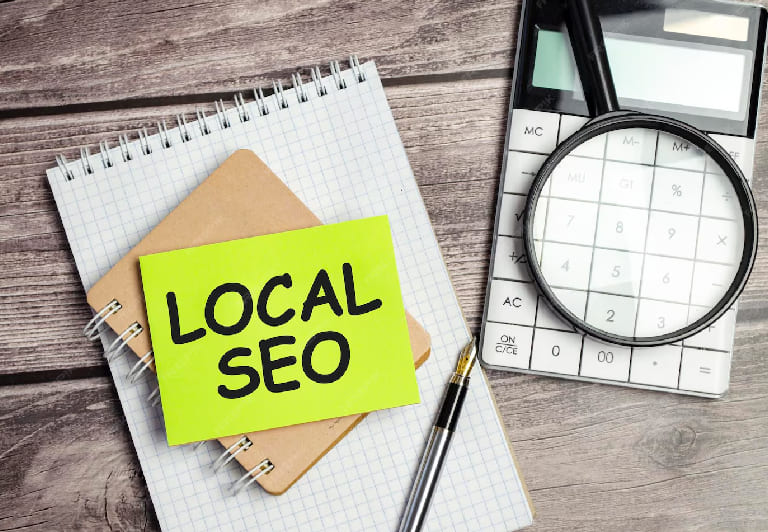Work Hours
Monday to Friday: 9AM - 6PM
Weekend: Closed

Competing with larger brands online can feel like an uphill battle for small and medium-sized businesses. When a potential customer searches for “[service] near me,” you want your business to appear at the top of the search results—not buried below your competitors. This is where Local SEO comes in.
Local SEO (Search Engine Optimization) helps small businesses, startups, e-commerce stores, and even enterprises increase visibility in local search results, attract nearby customers, and drive more leads without overspending on ads. In fact, 46% of all Google searches have local intent, meaning customers are actively searching for products and services in their area.
In this guide, we’ll walk you through proven Local SEO strategiesthat can help your business stand out in 2025. From optimizing your Google Business Profile to earning local backlinks, these steps are practical, cost-effective, and designed to generate real results.
What is Local SEO (and Why It Matters for Small Businesses)

Local SEO is the process of optimizing your online presence so your business appears in local search results—particularly in Google’s “Local Pack” (the map + 3 listings that appear at the top).
Unlike general SEO, which focuses on ranking for keywords globally or nationally, Local SEO is all about location-specific visibility. If you’re a plumber, dentist, boutique, or restaurant, showing up in local search results can directly lead to more calls, visits, and sales.
Some key benefits of Local SEO include:
- Increased foot traffic: Get found by customers nearby who are ready to buy.
- Higher trust: Appearing in the local map pack boosts credibility.
- Cost-effective marketing: Organic local traffic is free compared to PPC ads.
- Better lead quality: Local searchers typically have higher intent to purchase.
Step 1: Optimize Your Google Business Profile
Your Google Business Profile (GBP), formerly Google My Business, is one of the most powerful tools for local SEO. It helps Google understand your business and allows customers to find essential details like your address, phone number, and hours of operation.
Here’s how to optimize it:
1. Claim and Verify Your Profile
If you haven’t already, claim your listing at Google Business Profile Manager and go through the verification process.
2. Complete Your Business Information
Ensure your Name, Address, and Phone Number (NAP) are correct and consistent across all platforms. Add your website, business hours, and service areas.
3. Choose Accurate Categories
Pick a primary category that describes your business best and secondary categories for additional services you offer.
4. Write a Compelling Business Description
Include local keywords (e.g., “affordable plumber in Dallas”) naturally in your description. Keep it clear and professional.
5. Add High-Quality Photos & Videos
Businesses with photos get 42% more requests for directions and 35% more clicks to their websites, according to Google. Showcase your storefront, team, and products.
6. Collect & Respond to Reviews
Encourage happy customers to leave reviews and respond to all feedback—both positive and negative. Google considers review activity a ranking factor.
7. Post Regular Updates
Use the posts feature to share promotions, events, and blog links. Fresh content signals activity to Google.
8. Track Performance
Use UTM parameters on your website link so you can measure how much traffic your GBP is driving in Google Analytics.
Step 2: Build Consistent Local Citations
A local citation is any mention of your business name, address, and phone number online. These citations help search engines confirm your business is legitimate and located where you say it is.
Where to Build Citations
- Major Directories: Yelp, YellowPages, Apple Maps, Bing Places.
- Industry-Specific Directories: Houzz (home improvement), Avvo (legal), Zocdoc (healthcare).
- Local Directories: Your city’s Chamber of Commerce website, local business associations, and community portals.
Best Practices for Citations
- Keep NAP information consistent across all listings. Even small discrepancies (e.g., “St.” vs. “Street”) can hurt rankings.
- Avoid duplicate listings. If you find them, request removal.
- Update citations when you change address, phone number, or hours.
A strong citation profile builds trust with both Google and potential customers.
Step 3: Earn Local Backlinks
Backlinks are still one of the strongest ranking factors in SEO. But for Local SEO, locally relevant backlinks carry even more weight.
How to Get Local Backlinks
- Local Sponsorships: Sponsor community events, charity runs, or youth sports teams and get a backlink from their website.
- Partnerships: Collaborate with complementary businesses and exchange links (e.g., a wedding photographer and florist cross-promoting each other).
- Local Press & PR: Pitch stories to local newspapers or bloggers about your business milestones or community involvement.
- Guest Blogging: Write helpful content for local websites or chambers of commerce.
- Testimonials: Offer testimonials for vendors or partners in exchange for a backlink.
Pro Tip: Use tools like Ahrefs or Moz to see which local websites link to your competitors and reach out to get listed as well.
Step 4: Create Locally Relevant Content
Publishing localized content helps Google connect your business with your community.
Content Ideas for Local SEO
- Blog posts about local events and news.
- “Best of” lists for your industry in your city (e.g., “Top 5 Places to Buy Office Furniture in Austin”).
- Case studies featuring local customers or projects.
- Service-area landing pages targeting different neighborhoods or cities you serve.
Don’t Forget Schema Markup
Implement the Local Business schema on your website so Google understands your location details better.
Step 5: Track and Measure Your Results
Local SEO isn’t a one-time effort—it’s an ongoing process. Monitor your performance and keep improving.
Key Metrics to Watch
- Local Rankings: Are you appearing in the “map pack” for your target keywords?
- Website Traffic: Use Google Analytics to track organic visits from local search.
- Engagement: Track calls, direction requests, and website clicks from your GBP.
- Conversions: Are you getting more leads, calls, and sales from local visitors?
Tools to Use
- Google Search Console: Monitor impressions and clicks for local keywords.
- BrightLocal / Moz Local: Track local rankings and citations.
- GBP Insights: See how many people called or requested directions from your listing.
A strong citation profile builds trust with both Google and potential customers.
Conclusion
Local SEO gives small businesses a powerful way to compete with larger competitors, generate more leads, and attract nearby customers. By optimizing your Google Business Profile, building consistent citations, earning local backlinks, and publishing localized content, you can dominate local search results and grow your business organically. Remember, Local SEO is not a one-time project—it’s an ongoing effort. Start with the strategies above, measure your results, and refine your approach over time.
Ready to improve your local rankings?
Request a free Local SEO audit and discover exactly what’s holding your business back from ranking higher.

